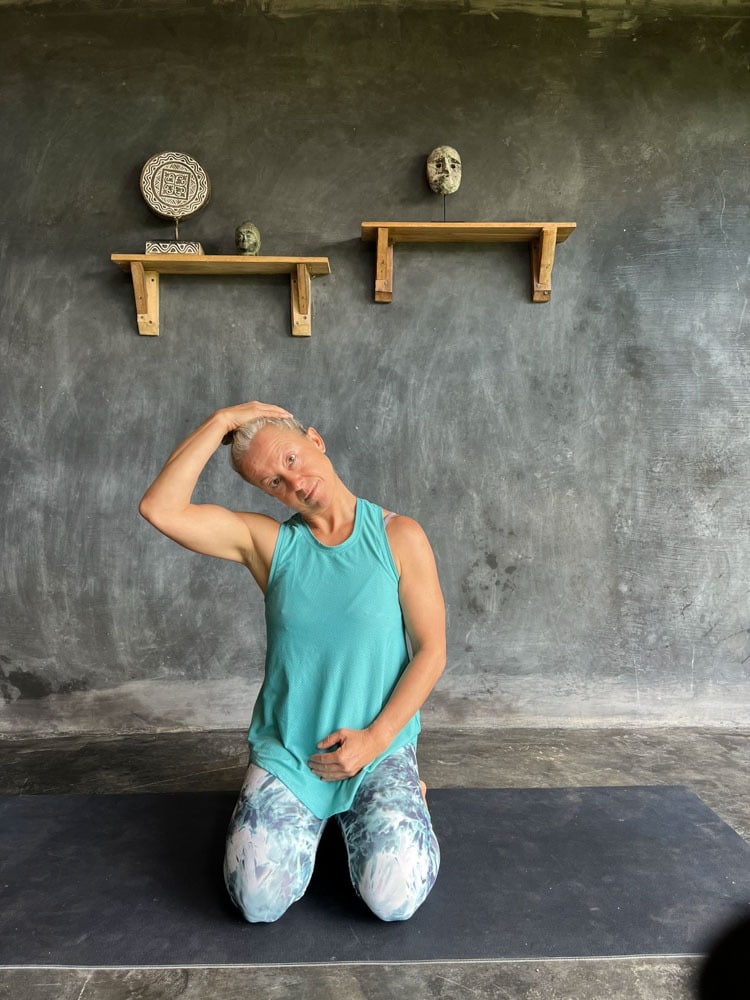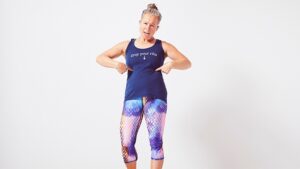I have a long history with neck pain – it used to be so bad that I’d have to miss work. These days it’s not much of issue for me (yay better movement and getting my tongue tie released!). But I do still get some neck stuff especially when I spend lots of time on my computer. And my partner Chris still struggles with neck pain, since surfing is super hard on his neck. In today’s post, I’m sharing some neck tips and my favourite neck relief work out.
Why Do Necks Get So Sore?
Our necks typically hurt because we don’t move enough, and we don’t move in the right ways. Necks are pretty delicate, and heads are heavy, so they really take a beating when we spend all day staring at computers and screens.
Plus it’s really common for us to hold tension in the back of the neck and the shoulders – it’s a natural reaction to stress, but most of us are stressed way more than is natural. This constant tension, ironically, weakens our neck muscles and makes us more prone to neck pain.
So what we want to do to help out is to get our necks stronger and moving better. This will help decrease that held tension and improve neck feeling and function.
Side note: The way we walk is also a problem for our necks. Because our back lines are weak and short from sitting and shoes, we lean forward a lot when we walk. This creates a constant ‘mini-whiplash’ effect on our necks that they were never meant to experience. So working on walking can be a key part of a permanent neck pain solution. Bodies are complicated! Here’s a post with some walking basics if you want to take a deeper dive.
My Favourite Neck Rescue Exercises
I’m super excited to share this class – it’s our go-to whenever our necks aren’t feeling the best.
You’re going to need a yoga block (a firm cushion could work), a yoga strap (or belt) and two Yoga Tune Up balls or tennis balls. Please do NOT use super hard balls like lacrosse balls, we’re going for gentle and kind here.
As always, listen to your body when you do this work. You’re in control and you know best so if something doesn’t feel right, don’t do it! Movement is one of the best ways to decrease pain and discomfort but dosage is important – go slow and easy and be kind!
You can jump right into the class, but if you want a deeper dive, scroll down to find out why I’ve included each of the exercises you’re going to experience.
What’s In The Workout And Why
Here’s what you’re going to experience, and why I’ve included it.
All Day Neck Moves
How we hold our neck all day really makes a difference in how it feels. And learning better head and neck alignment will also help you do the neck workout more safely and effectively.
We’re going to start by practicing ‘head ramping’ to help you get your head into a great position for the workout. Then you get an awesome takeaway because you can practice ramping your head all-day, every day (especially when you’re looking at a screen or driving).
Neck CARs
I start and finish my neck routine with Controlled Articular Rotations for the neck. Neck CARs help assess our neck function, maintain neck joint health and to help our bodies and nervous systems integrate the benefits of the work-out when we’re done.
If you feel any closing angle pain during this exercise, make your movement smaller so you no longer feel any pinching (the closing angle is the side of the joint that’s getting smaller. For instance, it’s closing angle pain if I’m leaning my left ear to my left shoulder and feel pain in the left side of my neck). If you do experience any closing angle pain, it’s a good idea to see a Functional Release certified practitioner for some help here. And if you’ve been told you have osteoporosis in your neck, please clear these with your doctor!
Neck CARs are another great take-away tool that will help you improve your neck health – I teach them in more detail (along with the rest of the body CARs) in my Joints For Life course. The shoulder CARs and the scapular CARs are also really great tools for a happier neck.
Neck and Shoulder Rolling
Now it’s time for the delicious stuff! Using balls to gently roll out tension is one of the nicest ways to reconnect with our bodies. The key here is being GENTLE; you should be able to maintain nice, relaxed breathing at all times. Here’s why I love ball rolling:
1️⃣ It helps us improve our brain body connection (a big key to better movement).
2️⃣ It helps us learn how to relax our muscles – this can be hard when we have a habit of holding tension.
3️⃣ It feels great! Movement can and should feel wonderful, and our bodies are a great source of pleasure – it’s really good to reconnect with this!
Neck Isometrics
Now that our muscles are warmed up and relaxed, we’re going to use them – because muscles LOVE to be used. But we’re going to use them in a cool way using isometrics.
‘Isometric’ means creating muscle tension without creating joint movement or changing muscle length. Neck isometrics are the secret sauce here. The whole class is great work, but neck isometrics are REALLY powerful. A lot of the time when we feel like our muscles are ‘tight’ it’s actually because they aren’t strong enough and aren’t being used enough. So here’s a chance to ask our necks to do some really awesome stuff.
Isometrics are a truly incredible tool and here’s why:
1️⃣ Isometrics are super safe. Because you don’t move when you do an isometric, you get the benefits of muscle contraction with no shearing or wear and tear. That means blood flow, tissue healing and more muscle strength with less chance of irritation or damage. Yay!
2️⃣ Isometrics are natural painkillers. Research has shown that isometric contractions can have an immediate and significant analgesic effect – and I’ve felt it in my own body too! (For example see this study on isometrics for neck pain.)
3️⃣ Isometrics are the only type of muscle contraction that doesn’t create an inflammatory response, and it helps reduce any damage that can be caused by more strenuous concentric and eccentric contraction.
Finishing Up
We’re going to finish things with a little bit of extra moving to really get those neck muscles stronger – especially the deep neck flexors in the front. This is my favourite part! And then of course a couple more neck CARs to get everything integrated and happy.
Now For The Take Aways!
So I hope your neck now feels AMAZING – this work out is always a game changer for me! But, bodies don’t change overnight. You can do this class every day, for sure, but if you want something a bit easier and faster, I’d recommend two simple tools to carry forward.
Neck CARs every day
You can do light Neck CARs a lot. Really a lot. I do them at least 3x each way every morning, and if my neck is sore, I’ll up that to many times a day – 10, 12, 16, whatever, as long as my neck is ok with it. They’re a great way to keep things moving, assess where you’re at, and maintain the health of your cervical spine. Scapula and shoulder CARs are also really helpful and you can learn those in both my Joints for Life program and my Take10 movement membership. But remember, never go into closing angle pain!
Keep Your Head Ramped Up
Check in with your head and neck regularly – like, a billion times a day – and if it’s sticking out in front of you, ramp it back up. The more you practice, the easier this will become, until someday your head will live above your shoulders where it belongs! In the meantime, each time you ramp up, you’re giving your neck a break.
If you enjoyed the exercises in this post and are looking for more ways to explore and deepen your movement journey, make sure to get on the waitlist for my Take10 membership program. Take10 will help you build a movement-rich lifestyle so you can live the active life you dream about for decades to come!





